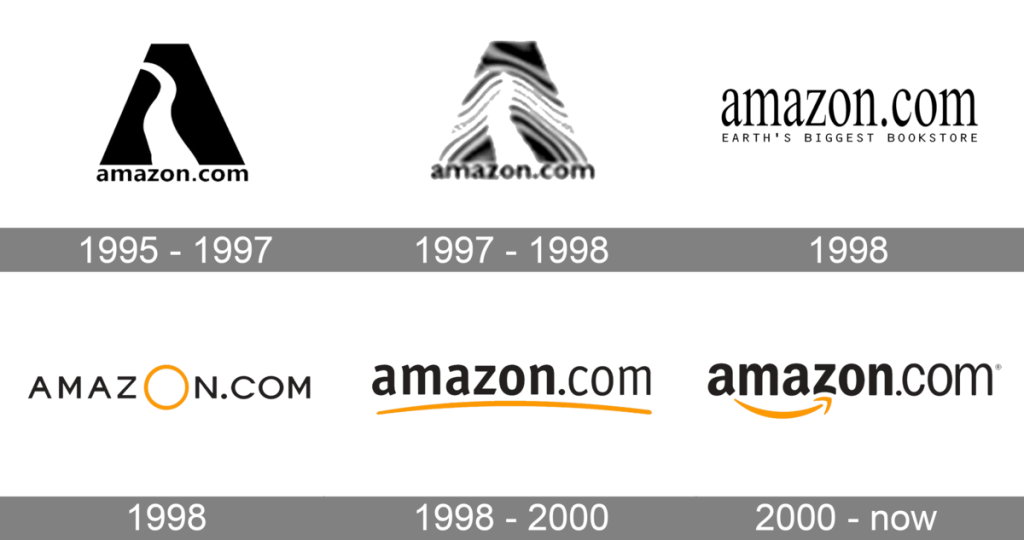The story of Amazon’s emblem is a remarkable journey, mirroring the epic trajectory of the company from a humble online bookstore to the world’s retail titan. The logo, a company’s visual identity, reflects its ethos, ambitions, and the essence of its brand. Over the years, Amazon’s logo has evolved, each iteration signifying a new era of growth and vision. This chronicle of the Amazon logo is not merely about aesthetic changes; it’s about how a design encapsulates a brand’s message and the promise it holds for its customers.
Amazon is a multinational technology and retail giant based in Seattle, Washington. Founded by Jeff Bezos on July 5, 1994, it started as an online marketplace for books under the name “Cadabra” but expanded to sell a wide variety of consumer goods and digital media. Amazon has since grown to become one of the world’s largest e-commerce companies. It also has a strong presence in other sectors such as cloud computing through its Amazon Web Services (AWS), artificial intelligence, streaming media through Amazon Prime, and more. With its vast product selection, technological innovations, and extensive logistics network, Amazon plays a significant role in the modern global retail and technology landscape.
The First Amazon Logo 1995 to 1997

The narrative of Amazon’s logo starts in the mid-90s when the digital frontier was just burgeoning. In 1995, Amazon introduced its first logo, a humble design that featured the company’s name “amazon.com” in a black, serif font, coupled with a slogan, “Earth’s Biggest Bookstore.” This logo reflected Amazon’s initial venture as an online bookstore, a modest start yet with a bold ambition encapsulated in the slogan. The word “Amazon” wasn’t merely a company name; it was a representation of the vast and diverse range of books the company aimed to offer, much like the vastness of the Amazon river rainforest. The “.com” emphasized the new, digital frontier that the company was venturing into.
During this phase, the logo succinctly communicated to its customers the core of Amazon’s offering – an extensive collection of books available online. The simplicity of the design, the straightforward typography, and the clarity of the message were emblematic of a startup setting the stage for a digital retail revolution.
Amazon Logo from 1997 to 1998

As the digital tide continued to swell, Amazon wasn’t just riding the wave but becoming a formidable wave-maker. The year 1997 marked a seminal phase in Amazon’s branding saga. The company was gradually transcending its original identity as a bookstore, heralding its foray into a broader retail domain. This transitional phase beckoned a logo that could encapsulate the expanding horizon of Amazon’s retail offerings.
In 1997, the logo underwent a subtle yet significant metamorphosis. The serif font was replaced with a sans-serif one, lending a modern, cleaner look. The tagline “Earth’s Biggest Bookstore” was dropped, signaling a departure from being a bookstore to a more versatile retail platform. However, the logo retained the company name, still emphasizing its digital domain with the “.com” suffix.
This change was not just a design overhaul but a deliberate stride towards echoing the broader scope of Amazon’s business. The simplified logo began embodying a company that was steadily outgrowing its initial identity, ready to venture into new retail realms. It subtly conveyed that Amazon was no longer just a bookstore but was evolving into a comprehensive retail platform.
The new logo was a precursor to the more iconic logo that would soon follow. It was during this phase that the seeds were sown for a logo that would go on to become synonymous with online retail. The logo now had a modern appeal, one that resonated with the dynamism and the forward-thinking ethos of the company.
Amazon Logo from 1998 to 2000

The dawn of a new millennium heralded a new epoch in the annals of Amazon’s branding narrative. As the calendar flipped to 1998, Amazon was swiftly morphing from a burgeoning online bookstore to a behemoth in the online retail landscape. This metamorphosis was a clarion call for a logo that could mirror the expansive, all-encompassing retail platform that Amazon was sculpting. The logo needed to be more than just a name; it needed to be a narrative, a story encapsulating the ethos and the essence of Amazon’s brand.
In 1998, the emblem of Amazon underwent a revolutionary redesign, crafting a logo that has become emblematic of online retail today. The word ‘Amazon’ was now adorned in a sleek, modern sans-serif typography, accompanied by a striking yellow arrow swooping from the letter ‘a’ to ‘z’. This wasn’t just a design; it was a doctrine. The arrow symbolized a smile, embodying the gratification and satisfaction Amazon endeavored to deliver to its customers. Furthermore, the arrow’s stretch from ‘a’ to ‘z’ was a visual articulation of Amazon’s ambition to offer everything from A to Z, a reflection of the colossal spectrum of products the platform was now home to.
This design didn’t just modernize the logo; it enshrined the customer-centric ethos of Amazon. The smile was an invitation, a warm, friendly ushering for customers to a platform that promised a vast, varied, and vibrant retail experience. The simplicity yet the profundity of the design made it more than just a logo. It was now a symbol, a narrative, a promise, and a reflection of Amazon’s customer-centric ethos and its boundless retail offering.
Amazon Logo from 2000 to Present

As we transitioned into the new millennium, the current Amazon logo maintained consistency, becoming a visual synonym for online retail. Despite the company’s monumental growth and diversification, the logo has seen minimal alterations, a testament to its enduring representation of Amazon’s brand ethos.
The design elements of the logo, particularly the iconic yellow curved arrow, have become deeply ingrained in the consumer psyche. This arrow, resembling a smile, reflects Amazon’s customer-centric approach, symbolizing the satisfaction and delight the company aims to deliver with every transaction. Furthermore, the arrow’s stretch from ‘a’ to ‘z’ subtly communicates Amazon’s vast product offering, embodying the essence of a one-stop shop for a plethora of consumer needs.
The logo’s simplicity, coupled with its profound symbolic representations, echoes Amazon’s brand identity. It reflects a brand that prioritizes customer satisfaction, values ease of access, and celebrates the vast diversity of its product offerings. The modern, sleek design of the logo aligns with the contemporary, innovative, and customer-centric ethos of Amazon, making it a timeless symbol in the dynamic, ever-evolving digital retail landscape.
The congruence between Amazon’s brand identity and its logo showcases a masterful melding of design and brand ethos. The logo is not merely a visual identifier; it’s a narrative of Amazon’s mission to provide an exhaustive, enjoyable, and easy shopping experience to its customers across the globe.

Future Prospects for Amazon’s Branding
As Amazon continues to evolve and expand its horizons, its branding, including the logo, might see evolutionary shifts to reflect the company’s ever-broadening scope and innovative spirit. While the core essence is likely to remain intact, subtle design tweaks to stay contemporary and resonant with the changing consumer expectations and market trends might be on the horizon. All current Amazon logos you can download here.
Amazon Logo Icon
The iconography of the Amazon logo, particularly the symbolic arrow, has become a cornerstone of its brand identity. This emblematic arrow not only conveys a smile but also subtly nods to the vast array of products available on the platform, showcasing a clever use of design to narrate a brand story.
Amazon Logo Colors
The color scheme, dominated by black and orange, is striking and easily recognizable. The black typography exudes a sense of professionalism and reliability, while the orange arrow injects a dose of warmth, enthusiasm, and customer-centricity into the brand image. This color balance plays a pivotal role in making the logo both appealing and memorable.
Amazon Logo Font
The typography in the Amazon logo is custom, simplistic yet modern, ensuring readability across various platforms and devices. Its sleekness reflects a modern, forward-thinking brand, making it easily identifiable and resonant with the digital age’s aesthetic sensibilities. The typeface employed in the logo from 1998 to 2000 was recognized as Officina Sans Bold.
Ready to design your own logo? Create it in minutes with the Logomak online logo generator.
Frequently asked questions about the FedEx logo
1. What does the Amazon logo represent?
The Amazon logo embodies the company’s customer-centric ethos and its broad product range. The distinctive arrow, resembling a smile, signifies customer satisfaction and the company’s aim to deliver a positive shopping experience. Additionally, the arrow stretches from ‘a’ to ‘z’, symbolizing Amazon’s ambition to offer an extensive range of products—from A to Z.
2. What is the significance of the arrow in the Amazon logo?
The arrow in the Amazon logo serves multiple purposes:
It resembles a smile, representing the company’s commitment to customer satisfaction.
It stretches from the letter ‘a’ to the letter ‘z’, indicating Amazon’s wide product offering—implying that customers can find everything from A to Z on the platform.
3. Has the Amazon logo won any design awards?
While the design of the Amazon logo is widely recognized and appreciated for its clever use of symbolism and simplicity, there isn’t public information on specific awards it might have won.
4. Who created the Amazon logo?
The Amazon logo, as we know it today with the smile and the arrow from ‘a’ to ‘z’, was created by a graphic designer named Turner Duckworth. The design is clever and symbolic, representing the company’s mission to make customers happy and to provide a vast array of products, literally from A to Z. The simplicity and cleverness of the logo have contributed to it becoming one of the most recognizable logos in the world.
5. Who created the Amazon company?
Amazon was founded by Jeff Bezos in 1994, July 5. Initially, Amazon started as an online bookstore from Bezos’ garage before expanding to sell a wide variety of products. Under Bezos’ leadership, Amazon grew to become one of the world’s largest e-commerce platforms and a significant player in other areas such as cloud computing, digital streaming, and artificial intelligence. Jeff Bezos led Amazon as its CEO until July 5, 2021, when Andy Jassy, the former CEO of Amazon Web Services, took over the role.
Conclusion
The journey of the Amazon logo is a compelling narrative of how a brand’s visual identity evolves alongside its growth, ambitions, and the market it operates within. The logo has not just witnessed the transformation of Amazon from an online bookstore to a global retail titan but has played a significant role in communicating the brand’s ethos, customer-centric approach, and the promise of an extensive product range. As Amazon marches into the future, its logo remains a timeless emblem, continuing to embody the brand’s essence and narrate its remarkable story in the competitive retail landscape.





